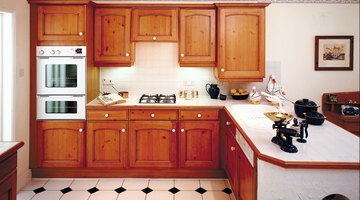Thermofoil Vs. Laminate
When you become a homeowner and want to tackle some basic home improvement projects, you will inevitably become familiar with the materials used, such as thermofoil and laminate.

Understanding the difference between these two materials, commonly associated with cabinets, counter tops, floors and more, requires a basic knowledge of each. Ultimately, thermofoil differs from laminate in a very fundamental way, appearing in more limited applications than laminate.
Laminate
Laminate is a generic term that refers to any substance used to coat or cover another substance. In the home, laminate appears on floors, counters, cabinets and even wood surfaces, including bookshelves. Laminate for cabinets and counter tops almost always constitutes a form of plastic created by mixing paper and plastic resin. This substance hardens to form a bond with other materials, creating a protective layer. Outside the home, laminates also contain mostly plastic, though some metal laminates exist.
Thermofoil
Thermofoil is a laminating material on medium density fiberboard (MDF). Manufacturers use MDF primarily in the construction of doors and cabinets due to the material’s resemblance to wood. MDF is a mixture of sawdust and bonding material, such as glue, that hardens to form a surface in the shape of any mold in which you pour it. Manufacturers laminate MDF with thermofoil, a type of vinyl covering that contains PVC, to give it sheen and additional protection. Thermofoil creates a seamless and stain-resistant coating on MDF, though it chips easily. MDF contains formaldehyde, a toxic chemical.
Terminology
The fundamental differences between thermofoil and laminate stem from their terminology. Laminate refers to any type of material used in the laminating process, whereas thermofoil constitutes a very specific type of PVC vinyl coating. Thermofoil comprises just one of the numerous laminates used in and around the home. Though thermofoil refers to a very specific type of laminate, companies that manufacture thermofoil or thermofoil-coated materials may use different processes in the creation and application of thermofoil.
Applications
Thermofoil only appears on cabinets, doors and other surfaces made of MDF. Laminate, on the other hand, appears in a wide variety of products, ranging from erasable whiteboards to photographs, floors and metal sinks. Dentists even use various types of laminates on teeth to protect them while creating a natural look. Though thermofoil is available for only very limited applications, it comes in a variety of colors so that MDF products resemble the natural wood products they mimic.
The Drip Cap
- When you become a homeowner and want to tackle some basic home improvement projects, you will inevitably become familiar with the materials used, such as thermofoil and laminate.
- Ultimately, thermofoil differs from laminate in a very fundamental way, appearing in more limited applications than laminate.
- MDF contains formaldehyde, a toxic chemical.
- Laminate, on the other hand, appears in a wide variety of products, ranging from erasable whiteboards to photographs, floors and metal sinks.
- Though thermofoil is available for only very limited applications, it comes in a variety of colors so that MDF products resemble the natural wood products they mimic.
References
- U.S. Customized: Theromofoil
- Popular Mechanics; "Metal Laminate"; April 1989
- Home Style Choices: Kitchen Cabinet Construction 101
- “Porcelain Laminate Veneers for Dentists and Technicians”; Roger J. Smales and Frederick C.S. Chu; 1999
Writer Bio
Will Gish slipped into itinerancy and writing in 2005. His work can be found on various websites. He is the primary entertainment writer for "College Gentleman" magazine and contributes content to various other music and film websites. Gish has a Bachelor of Arts in art history from University of Massachusetts, Amherst.
Photo Credits
- Jupiterimages/Photos.com/Getty Images
- Jupiterimages/Photos.com/Getty Images
More Articles



